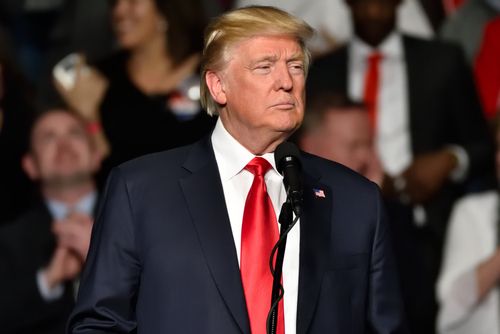President Trump says he is preparing to drop tariffs against China
- Markets in 2026: Will gold, Bitcoin, and the U.S. dollar make history again? — These are how leading institutions think
- Trump says Venezuela's Maduro deposed, captured after US strikes
- Bitcoin Price Surges To $90,000. U.S. Arrests Venezuela's President, Triggers Bull Frenzy
- After Upheaval in the World’s Largest Oil Reserve Holder, Who Will Emerge as the Biggest Winner in Venezuela’s Oil Market?
- U.S. to freeze and take control of Venezuela's Bitcoin holdings after Maduro capture
- Ethereum Price Forecast: Accumulation addresses post record inflows in December despite high selling pressure

President Donald Trump is finally saying out loud what both Beijing and Wall Street have been waiting to hear. He told reporters Thursday that the 145% import tariffs slapped on China since his return to the White House are likely coming down.
“You can’t get any higher. It’s at 145, so we know it’s coming down,” he said at a press conference where he also revealed a separate tariffs deal with the UK.
This was the strongest signal yet that the two largest economies on the planet are preparing to dial down the trade fight that’s been hitting global markets for months, according to the BBC.
The meeting to discuss the tariff rollback will take place this weekend in Switzerland, with both sides sending top-level officials. The US is dispatching Treasury Secretary Scott Bessent, while China will be represented by Vice Premier He Lifeng, the country’s main economic policymaker.
Even though the first round will be technical, everyone involved knows this can’t get done without the two leaders stepping in eventually. “I think everyone recognizes that any final deal will require the active engagement of both presidents,” said Stephen Olson, a former US trade negotiator.
Trump says the China meeting will be ‘friendly’
At the same event where he unveiled the UK trade agreement, Trump described the upcoming China talks as peaceful. “I think it’s a very friendly meeting. They look forward to doing it in an elegant way,” he said. On the Chinese side, Vice Foreign Minister Hua Chunying had the same energy.
Hua said Beijing had “full confidence” in its ability to manage the trade tensions with Washington. Both sides have been getting hit by mounting economic pressure, and analysts say they’re starting to act like it.
Dan Wang, a political risk consultant at Eurasia Group, told the BBC that the latest signs suggest both governments are open to deal-making. “The recent signals from both sides suggest a transactional de-escalation is on the table,” she said.
But that doesn’t mean the core issues are anywhere close to getting fixed. “The systemic frictions between the US and China will not be resolved any time soon,” Olson warned. Olson also believes any tariff reductions that come from the upcoming meeting will be minimal. “Any cuts to tariffs as a result of this meeting are likely to be minor,” he added.
Eswar Prasad, former head of the IMF’s China division, backed that up, saying even if Trump walks back the latest tariffs, the two countries still have a long road ahead. “A realistic goal is probably at best a pullback from the sky-high bilateral tariffs, but that would still leave in place high tariff barriers and various other restrictions,” Prasad said.
China’s exports drop as pressure grows on both sides
On Friday, China’s Ministry of Commerce published trade data for April showing exports to the US had dropped more than 20% compared to the same time last year. At the same time, its total exports climbed 8.1%, higher than analysts expected.
That shows China is managing to move trade elsewhere while still getting hurt by the loss of US business. For Trump, those numbers could add weight to the need to de-escalate fast, especially ahead of his 2025 reelection campaign.
The Switzerland meeting will happen two days after Trump’s administration struck a new tariffs agreement with the UK, making it the first country to cut a formal deal under the new round of import taxes.
Under the agreement, the US will lower duties on a specific set of British cars and allow a batch of steel and aluminum to enter tariff-free. Some other UK industries will also get temporary relief from Trump’s new tariffs, which have been in place since January.
Read more
* The content presented above, whether from a third party or not, is considered as general advice only. This article should not be construed as containing investment advice, investment recommendations, an offer of or solicitation for any transactions in financial instruments.

